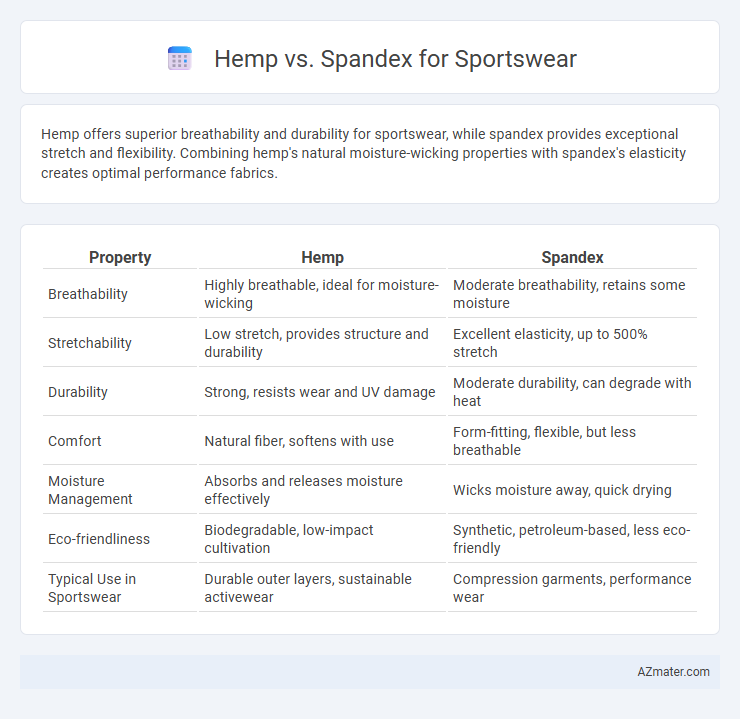Hemp offers superior breathability and durability for sportswear, while spandex provides exceptional stretch and flexibility. Combining hemp's natural moisture-wicking properties with spandex's elasticity creates optimal performance fabrics.
Table of Comparison
| Property | Hemp | Spandex |
|---|---|---|
| Breathability | Highly breathable, ideal for moisture-wicking | Moderate breathability, retains some moisture |
| Stretchability | Low stretch, provides structure and durability | Excellent elasticity, up to 500% stretch |
| Durability | Strong, resists wear and UV damage | Moderate durability, can degrade with heat |
| Comfort | Natural fiber, softens with use | Form-fitting, flexible, but less breathable |
| Moisture Management | Absorbs and releases moisture effectively | Wicks moisture away, quick drying |
| Eco-friendliness | Biodegradable, low-impact cultivation | Synthetic, petroleum-based, less eco-friendly |
| Typical Use in Sportswear | Durable outer layers, sustainable activewear | Compression garments, performance wear |
Introduction to Hemp and Spandex in Sportswear
Hemp is a durable, eco-friendly natural fiber renowned for its breathability and moisture-wicking properties, making it ideal for sustainable sportswear. Spandex, a synthetic fiber known for its exceptional elasticity, provides superior stretch and shape retention, enhancing comfort and performance in activewear. Combining hemp's sustainability with spandex's flexibility results in innovative sportswear materials that balance environmental benefits with functional athletic support.
Material Origins: Natural vs Synthetic Fibers
Hemp fabric, derived from the natural fibers of the Cannabis sativa plant, offers breathability, durability, and eco-friendly qualities ideal for sustainable sportswear. Spandex, a synthetic fiber made from polyurethane, provides exceptional elasticity and shape retention, making it popular for form-fitting athletic apparel. Choosing between hemp and spandex results in a balance between natural fiber benefits like moisture-wicking and biodegradability versus the synthetic stretch and recovery essential for performance wear.
Sustainability and Environmental Impact
Hemp fibers offer a more sustainable alternative to spandex in sportswear due to their biodegradability, low water usage, and minimal pesticide requirements during cultivation. Spandex production relies heavily on non-renewable petrochemicals and involves energy-intensive manufacturing processes that contribute to greenhouse gas emissions. Choosing hemp-based activewear reduces environmental impact by supporting renewable resources and promoting eco-friendly textile options.
Comfort and Breathability Comparison
Hemp fabric offers superior breathability and moisture-wicking properties compared to spandex, making it ideal for intense physical activities that require temperature regulation and sweat evaporation. Spandex excels in stretchability and fit, providing exceptional comfort and freedom of movement, but it lacks the natural ventilation and antimicrobial benefits inherent to hemp. Choosing between hemp and spandex depends on prioritizing either breathable, eco-friendly comfort or flexible, form-fitting performance for sportswear applications.
Stretch and Flexibility Factors
Hemp fabric offers natural breathability and durability but lacks the inherent stretch and flexibility found in spandex, making it less ideal for high-mobility sportswear. Spandex, known for its exceptional elasticity, provides superior stretch and recovery, enabling unrestricted movement and enhanced performance during intense physical activities. Blending hemp with spandex combines the sustainability and strength of hemp with the flexible, form-fitting properties of spandex, optimizing comfort and functionality in sports apparel.
Durability and Wear Resistance
Hemp fabric offers superior durability and excellent wear resistance due to its natural long fibers, making it highly resistant to abrasion and stretching in sportswear applications. Spandex provides exceptional elasticity and flexibility but tends to degrade faster under repeated stress and exposure to sweat and UV rays. Combining hemp's toughness with spandex's stretch results in sportswear that balances strength and comfort while extending garment lifespan.
Moisture-Wicking and Odor Control
Hemp fibers naturally excel in moisture-wicking due to their breathability and high absorbency, keeping athletes dry during intense workouts. Spandex, while providing superior stretch and flexibility, lacks inherent moisture-wicking properties and often requires blending with other fabrics to manage sweat effectively. Hemp's antimicrobial qualities contribute to odor control by reducing bacteria buildup, whereas spandex can retain odors unless treated with specialized finishes.
Skin Sensitivity and Allergic Reactions
Hemp fabric is naturally hypoallergenic and antimicrobial, making it ideal for individuals with sensitive skin or prone to allergic reactions during sports activities. Spandex, while offering excellent stretch and flexibility, may cause irritation or allergic responses in sensitive users due to its synthetic fiber composition and chemical treatments. Choosing hemp-based activewear enhances breathability and reduces the risk of skin inflammation, promoting comfort and performance in athletic wear.
Performance and Athletic Suitability
Hemp fibers offer exceptional breathability, moisture-wicking properties, and natural antimicrobial benefits, making them highly suitable for athletic wear that demands comfort and odor control during intense workouts. Spandex provides superior elasticity and shape retention, supporting flexibility and unrestricted movement essential for high-performance sports activities. Combining hemp's durability and spandex's stretchability delivers optimal performance fabric for sportwear that balances sustainability with athletic functionality.
Cost, Availability, and Consumer Trends
Hemp offers a sustainable and cost-effective alternative to spandex in sportswear, with lower production costs due to its natural cultivation and durability. Spandex remains more widely available and favored for its superior elasticity and comfort, maintaining strong demand in performance apparel markets. Consumer trends increasingly favor hemp for eco-conscious athletes seeking breathable, biodegradable fabrics, while spandex continues to dominate fast-fashion and high-stretch activewear segments.

Infographic: Hemp vs Spandex for Sportwear
 azmater.com
azmater.com